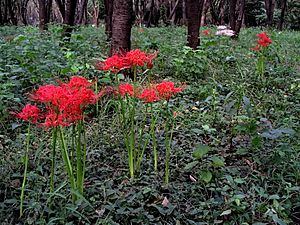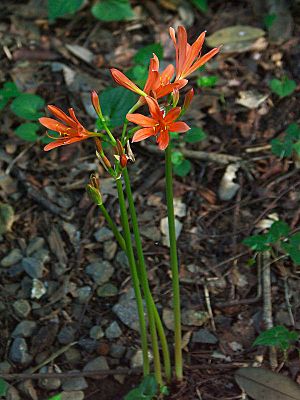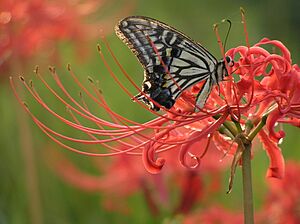Lycoris (plant) facts for kids
Quick facts for kids Lycoris (plant) |
|
|---|---|
 |
|
| Lycoris radiata a species with long stamens |
|
| Scientific classification |
|
| Kingdom: | Plantae |
| Clade: | Tracheophytes |
| Clade: | Angiosperms |
| Clade: | Monocots |
| Order: | Asparagales |
| Family: | Amaryllidaceae |
| Subfamily: | Amaryllidoideae |
| Tribe: | Lycorideae |
| Genus: | Lycoris Herb. |
| Synonyms | |
|
|
Lycoris is a group of 13 to 20 different kinds of flowering plants. They belong to the Amaryllidaceae family, which also includes daffodils and amaryllis. These plants originally come from eastern and southern Asia. You can find them in countries like China, Japan, Korea, and parts of Southeast Asia.
They have also been brought to other places, like North Carolina in the United States, where they now grow wild. In English, people often call them hurricane lilies or cluster amaryllis. Sometimes, they are also called spider lilies, a name they share with a few other related plants.
Contents
What Lycoris Plants Look Like
These plants grow from bulbs, like tulips or onions. They are perennial plants, meaning they live for more than two years. Their leaves are long and thin, usually about 30–60 cm (12–24 inches) long and only 0.5–2 cm (0.2–0.8 inches) wide.
The flowers grow on a tall, straight stem called a scape, which can be 30–70 cm (12–28 inches) tall. At the top of the stem, there's a cluster of four to eight flowers. These flowers can be white, yellow, orange, or red.
There are two main types of Lycoris flowers:
- Some have very long, thin stamens (the parts that hold pollen) that are two or three times longer than the flower petals. An example is Lycoris radiata.
- Others have shorter stamens that are not much longer than the petals. Lycoris sanguinea is an example of this type.
After the flowers bloom, they produce a small, three-part capsule that holds several black seeds. Many Lycoris species cannot reproduce with seeds and instead grow new plants from their bulbs. This often happens with plants that are hybrids, meaning they are a mix of two different species.
Different Kinds of Lycoris
As of 2015, scientists recognize 22 different species of Lycoris and one known hybrid. Here are some of them:
- Lycoris albiflora – also known as the white spider lily.
- Lycoris aurea – called the golden spider lily, found in China and Japan.
- Lycoris caldwellii – known as the magic lily.
- Lycoris chinensis – often called the yellow surprise lily.
- Lycoris incarnata – known as the peppermint surprise lily.
- Lycoris longituba – the long tube surprise lily.
- Lycoris radiata – a very common type, known as the red spider lily. It's found in Asia and has spread to places like the United States.
- Lycoris sanguinea – the orange spider lily, found in Japan.
- Lycoris sprengeri – sometimes called the tie dye surprise lily.
- Lycoris squamigera – known as the surprise lily, magic lily, or resurrection lily.
Some plants were once thought to be Lycoris but are now placed in other plant groups, like Griffinia and Ungernia.
Growing Lycoris Plants
Lycoris plants are grown all over the world as ornamental plants, which means they are grown for their beauty. They are very popular in China and Japan.
In Japan, farmers often plant them along the edges of rice paddy fields. They create a beautiful strip of bright flowers in the summer. There are more than 230 different types of Lycoris that people have chosen to grow in gardens!
In the southeastern United States, these plants have started to grow wild. People there sometimes call them "hurricane flowers" because they bloom around the time when hurricanes are most common. In China, Lycoris flowers are often used as decorations for festivals and celebrations.
Legends and Stories
Lycoris flowers, especially the red ones, have many interesting legends and stories connected to them, especially in Asian cultures.
Since these bright red flowers often bloom near cemeteries around the time of the September equinox (when autumn begins), they are sometimes linked to the afterlife. In some Chinese and Japanese stories, they are described as flowers that grow in the underworld and help guide spirits to their next life.
One famous legend explains why the flowers and leaves of Lycoris never appear at the same time. When the flowers bloom, the leaves have already fallen off. When the leaves grow, the flowers have wilted.
The legend tells of two elves: Mañju, who protected the flower, and Saka, who protected the leaves. They were not supposed to meet, but they were curious and found each other. They fell in love, but God was angry that they disobeyed. As a punishment, God separated them, cursing them so that the flowers of Mañju would never meet the leaves of Saka again.
It is said that when Mañju and Saka met after death in the underworld, they promised to find each other again after they were reborn. But they could never keep their promise.
To remember this sad story, some people call the plants "Mañjusaka," which combines the names "Mañju" and "Saka." In Japanese, this name is pronounced manju-syage.
Another legend says that if you see someone you might never meet again, these red spider lilies will bloom along your path. Because of these sorrowful stories, Japanese people often use these flowers in funerals. The popular Japanese name for Lycoris is Higanbana, which means "flower of higan" (the other shore of the Sanzu River, a mythical river of the afterlife). It can also mean a beautiful flower of the afterlife.
Images for kids
See also
 In Spanish: Lycoris para niños
In Spanish: Lycoris para niños
- List of plants known as lily








